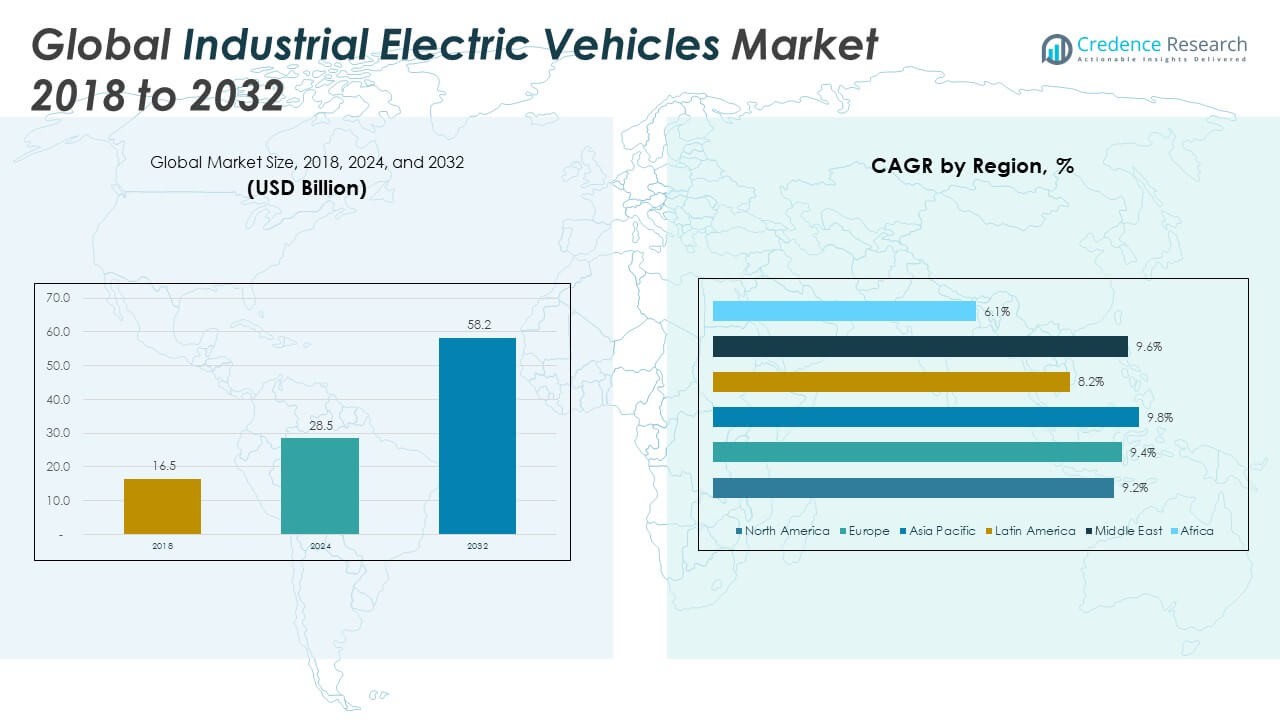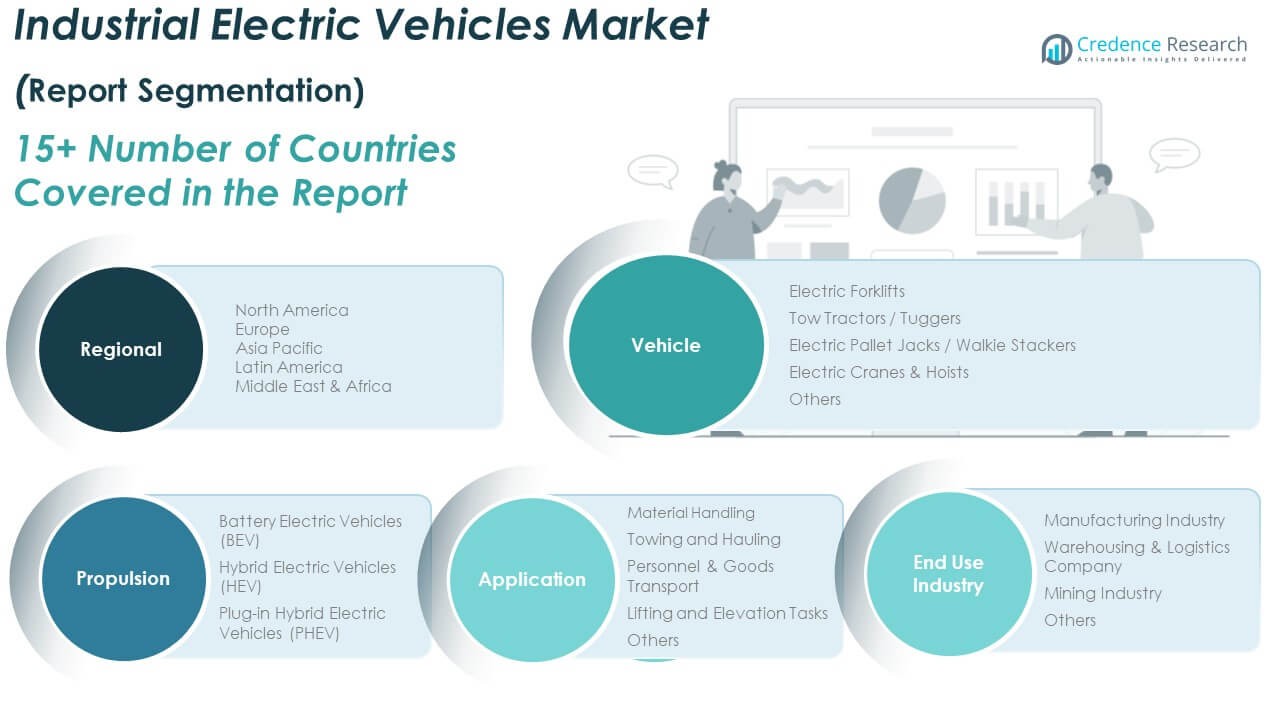CHAPTER NO. 1 :GENESIS OF THE MARKET
1.1 Market Prelude – Introduction & Scope
1.2 The Big Picture – Objectives & Vision
1.3 Strategic Edge – Unique Value Proposition
1.4 Stakeholder Compass – Key Beneficiaries
CHAPTER NO. 2 : EXECUTIVE LENS
2.1 Pulse of the Industry – Market Snapshot
2.2 Growth Arc – Revenue Projections (USD Billion)
2.3. Premium Insights – Based on Primary Interviews
CHAPTER NO. 3 :INDUSTRIAL ELECTRIC VEHICLES MARKET FORCES & INDUSTRY PULSE
3.1 Foundations of Change – Market Overview
3.2 Catalysts of Expansion – Key Market Drivers
3.2.1 Momentum Boosters – Growth Triggers
3.2.2 Innovation Fuel – Disruptive Technologies
3.3 Headwinds & Crosswinds – Market Restraints
3.3.1 Regulatory Tides – Compliance Challenges
3.3.2 Economic Frictions – Inflationary Pressures
3.4 Untapped Horizons – Growth Potential & Opportunities
3.5 Strategic Navigation – Industry Frameworks
3.5.1 Market Equilibrium – Porter’s Five Forces
3.5.2 Ecosystem Dynamics – Value Chain Analysis
3.5.3 Macro Forces – PESTEL Breakdown
3.6 Price Trend Analysis
3.6.1 Regional Price Trend
3.6.2 Price Trend by Vehicle
CHAPTER NO. 4 :KEY INVESTMENT EPICENTER
4.1 Regional Goldmines – High-Growth Geographies
4.2 Product Frontiers – Lucrative Product Categories
4.3 Vehicles Sweet Spots – Emerging Demand Segments
CHAPTER NO. 5: REVENUE TRAJECTORY & WEALTH MAPPING
5.1 Momentum Metrics – Forecast & Growth Curves
5.2 Regional Revenue Footprint – Market Share Insights
5.3 Segmental Wealth Flow – Vehicles, Propulsion, Application & End User Revenue
CHAPTER NO. 6 :TRADE & COMMERCE ANALYSIS
6.1.Import Analysis by Region
6.1.1. Global Industrial Electric Vehicles Market Import Volume By Region
6.2.Export Analysis by Region
6.2.1. Global Industrial Electric Vehicles Market Export Volume By Region
CHAPTER NO. 7 :COMPETITION ANALYSIS
7.1.Company Market Share Analysis
7.1.1. Global Industrial Electric Vehicles Market: Company Market Share
7.1. Global Industrial Electric Vehicles Market Company Volume Market Share
7.2. Global Industrial Electric Vehicles Market Company Revenue Market Share
7.3.Strategic Developments
7.3.1.Acquisitions & Mergers
7.3.2. New Product Launch
7.3.3. Regional Expansion
7.4. Competitive Dashboard
7.5. Company Assessment Metrics, 2024
CHAPTER NO. 8 :INDUSTRIAL ELECTRIC VEHICLES MARKET – BY VEHICLE SEGMENT ANALYSIS
8.1.Industrial Electric Vehicles Market Overview By Vehicle Segment
8.1.1. Industrial Electric Vehicles Market Volume Share By Vehicle
8.1.2. Industrial Electric Vehicles Market Revenue Share By Vehicle
8.2. Electric Forklifts
8.3. Tow Tractors / Tuggers
8.4. Electric Pallet Jacks / Walkie Stackers
8.5. Electric Cranes & Hoists
8.6. Others
CHAPTER NO. 9 :INDUSTRIAL ELECTRIC VEHICLES MARKET – BY PROPULSION SEGMENT ANALYSIS
9.1.Industrial Electric Vehicles Market Overview By Propulsion Segment
9.1.1. Industrial Electric Vehicles Market Volume Share By Propulsion
9.1.2. Industrial Electric Vehicles Market Revenue Share By Propulsion
9.2. Battery Electric Vehicles (BEV)
9.3. Hybrid Electric Vehicles (HEV)
9.4. Plug-in Hybrid Electric Vehicles (PHEV)
CHAPTER NO. 10 :INDUSTRIAL ELECTRIC VEHICLES MARKET – BY APPLICATION SEGMENT ANALYSIS
10.1.Industrial Electric Vehicles Market Overview By Application Segment
10.1.1. Industrial Electric Vehicles Market Volume Share By Application
10.1.2. Industrial Electric Vehicles Market Revenue Share By Application
10.2. Material Handling
10.3. Towing and Hauling
10.4. Personnel & Goods Transport
10.5. Lifting and Elevation Tasks
10.6. Others
CHAPTER NO. 11 :INDUSTRIAL ELECTRIC VEHICLES MARKET – BY END USER INDUSTRY SEGMENT ANALYSIS
11.1.Industrial Electric Vehicles Market Overview By End User Industry Segment
11.1.1. Industrial Electric Vehicles Market Volume Share By End User Industry
11.1.2. Industrial Electric Vehicles Market Revenue Share By End User Industry
11.2. Manufacturing Industry
11.3. Warehousing & Logistics Company
11.4. Mining Industry
11.5. Others
CHAPTER NO. 12 :INDUSTRIAL ELECTRIC VEHICLES MARKET – REGIONAL ANALYSIS
12.1.Industrial Electric Vehicles Market Overview By Region Segment
12.1.1. Global Industrial Electric Vehicles Market Volume Share By Region
12.1.2. Global Industrial Electric Vehicles Market Revenue Share By Region
12.1.3.Regions
12.1.4.Global Industrial Electric Vehicles Market Volume By Region
12.1.5.Global Industrial Electric Vehicles Market Revenue By Region
12.1.6. Vehicle
12.1.7. Global Industrial Electric Vehicles Market Volume By Vehicle
12.1.8.Global Industrial Electric Vehicles Market Revenue By Vehicle
12.1.9.Propulsion
12.1.10. Global Industrial Electric Vehicles Market Volume By Propulsion
12.1.11. Global Industrial Electric Vehicles Market Revenue By Propulsion
12.1.12. Application
12.1.13. Global Industrial Electric Vehicles Market Volume By Application
12.1.14. Global Industrial Electric Vehicles Market Revenue By Application
12.1.12. End User Industry
12.1.13. Global Industrial Electric Vehicles Market Volume By End User Industry
12.1.14. Global Industrial Electric Vehicles Market Revenue By End User Industry
CHAPTER NO. 13 :NORTH AMERICA INDUSTRIAL ELECTRIC VEHICLES MARKET – COUNTRY ANALYSIS
13.1.North America Industrial Electric Vehicles Market Overview By Country Segment
13.1.1.North America Industrial Electric Vehicles Market Volume Share By Region
13.1.2. North America Industrial Electric Vehicles Market Revenue Share By Region
13.2.North America
13.2.1.North America Industrial Electric Vehicles Market Volume By Country
13.2.2.North America Industrial Electric Vehicles Market Revenue By Country
13.2.3.Vehicle
13.2.4.North America Industrial Electric Vehicles Market Volume By Vehicle
13.2.5. North America Industrial Electric Vehicles Market Revenue By Vehicle
13.2.6.Propulsion
13.2.7.North America Industrial Electric Vehicles Market Volume By Propulsion
13.2.8. North America Industrial Electric Vehicles Market Revenue By Propulsion
13.2.9.Application
13.2.10. North America Industrial Electric Vehicles Market Volume By Application
13.2.11. North America Industrial Electric Vehicles Market Revenue By Application
13.2.12. End User Industry
13.2.13. North America Industrial Electric Vehicles Market Volume By End User Industry
13.2.14. North America Industrial Electric Vehicles Market Revenue By End User Industry
13.3.U.S.
13.4.Canada
13.5.Mexico
CHAPTER NO. 14 :EUROPE INDUSTRIAL ELECTRIC VEHICLES MARKET – COUNTRY ANALYSIS
14.1. Europe Industrial Electric Vehicles Market Overview By Country Segment
14.1.1. Europe Industrial Electric Vehicles Market Volume Share By Region
14.1.2. Europe Industrial Electric Vehicles Market Revenue Share By Region
14.2.Europe
14.2.1.Europe Industrial Electric Vehicles Market Volume By Country
14.2.2.Europe Industrial Electric Vehicles Market Revenue By Country
14.2.3.Vehicle
14.2.4. Europe Industrial Electric Vehicles Market Volume By Vehicle
14.2.5.Europe Industrial Electric Vehicles Market Revenue By Vehicle
14.2.6.Propulsion
14.2.7. Europe Industrial Electric Vehicles Market Volume By Propulsion
14.2.8. Europe Industrial Electric Vehicles Market Revenue By Propulsion
14.2.9.Application
14.2.10. Europe Industrial Electric Vehicles Market Volume By Application
14.2.11. Europe Industrial Electric Vehicles Market Revenue By Application
14.2.12. End User Industry
14.2.13. Europe Industrial Electric Vehicles Market Volume By End User Industry
14.2.14. Europe Industrial Electric Vehicles Market Revenue By End User Industry
14.3.UK
14.4.France
14.5.Germany
14.6.Italy
14.7.Spain
14.8.Russia
14.9. Rest of Europe
CHAPTER NO. 15 :ASIA PACIFIC INDUSTRIAL ELECTRIC VEHICLES MARKET – COUNTRY ANALYSIS
15.1.Asia Pacific Industrial Electric Vehicles Market Overview By Country Segment
15.1.1.Asia Pacific Industrial Electric Vehicles Market Volume Share By Region
15.1.2.Asia Pacific Industrial Electric Vehicles Market Revenue Share By Region
15.2.Asia Pacific
15.2.1. Asia Pacific Industrial Electric Vehicles Market Volume By Country
15.2.2.Asia Pacific Industrial Electric Vehicles Market Revenue By Country
15.2.3.Vehicle
15.2.4.Asia Pacific Industrial Electric Vehicles Market Volume By Vehicle
15.2.5.Asia Pacific Industrial Electric Vehicles Market Revenue By Vehicle
15.2.6.Propulsion
15.2.7.Asia Pacific Industrial Electric Vehicles Market Volume By Propulsion
15.2.8.Asia Pacific Industrial Electric Vehicles Market Revenue By Propulsion
15.2.9.Application
15.2.10. Asia Pacific industrial electric vehicles Market Volume By Application
15.2.11. Asia Pacific Industrial Electric Vehicles Market Revenue By Application
15.2.12. End User Industry
15.2.13. Asia Pacific Industrial Electric Vehicles Market Volume By End User Industry
15.2.14. Asia Pacific Industrial Electric Vehicles Market Revenue By End User Industry
15.3.China
15.4.Japan
15.5.South Korea
15.6.India
15.7.Australia
15.8.Southeast Asia
15.9. Rest of Asia Pacific
CHAPTER NO. 16 : LATIN AMERICA INDUSTRIAL ELECTRIC VEHICLES MARKET – COUNTRY ANALYSIS
16.1.Latin America Industrial Electric Vehicles Market Overview By Country Segment
16.1.1.Latin America Industrial Electric Vehicles Market Volume Share By Region
16.1.2.Latin America Industrial Electric Vehicles Market Revenue Share By Region
16.2. Latin America
16.2.1. Latin America Industrial Electric Vehicles Market Volume By Country
16.2.2.Latin America Industrial Electric Vehicles Market Revenue By Country
16.2.3. Vehicle
16.2.4. Latin America Industrial Electric Vehicles Market Volume By Vehicle
16.2.5. Latin America Industrial Electric Vehicles Market Revenue By Vehicle
16.2.6.Propulsion
16.2.7.Latin America Industrial Electric Vehicles Market Volume By Propulsion
16.2.8.Latin America Industrial Electric Vehicles Market Revenue By Propulsion
16.2.9.Application
16.2.10. Latin America Industrial Electric Vehicles Market Volume By Application
16.2.11. Latin America Industrial Electric Vehicles Market Revenue By Application
16.2.12. End User Industry
16.2.13. Latin America Industrial Electric Vehicles Market Volume By End User Industry
16.2.14. Latin America Industrial Electric Vehicles Market Revenue By End User Industry
16.3.Brazil
16.4.Argentina
16.5.Rest of Latin America
CHAPTER NO. 17 : MIDDLE EAST INDUSTRIAL ELECTRIC VEHICLES MARKET – COUNTRY ANALYSIS
17.1.Middle East Industrial Electric Vehicles Market Overview By Country Segment
17.1.1.Middle East Industrial Electric Vehicles Market Volume Share By Region
17.1.2. Middle East Industrial Electric Vehicles Market Revenue Share By Region
17.2.Middle East
17.2.1. Middle East Industrial Electric Vehicles Market Volume By Country
17.2.2.Middle East Industrial Electric Vehicles Market Revenue By Country
17.2.3.Vehicle
17.2.4.Middle East Industrial Electric Vehicles Market Volume By Vehicle
17.2.5.Middle East Industrial Electric Vehicles Market Revenue By Vehicle
17.2.6.Propulsion
17.2.7.Middle East Industrial Electric Vehicles Market Volume By Propulsion
17.2.8.Middle East Industrial Electric Vehicles Market Revenue By Propulsion
17.2.9. Application
17.2.10. Middle East Industrial Electric Vehicles Market Volume By Application
17.2.11. Middle East Industrial Electric Vehicles Market Revenue By Application
17.2.12. End User Industry
17.2.13. Middle East Industrial Electric Vehicles Market Volume By End User Industry
17.2.14. Middle East Industrial Electric Vehicles Market Revenue By End User Industry
17.3.GCC Countries
17.4. Israel
17.5. Turkey
17.6.Rest of Middle East
CHAPTER NO. 18 :AFRICA INDUSTRIAL ELECTRIC VEHICLES MARKET – COUNTRY ANALYSIS
18.1. Africa Industrial Electric Vehicles Market Overview by Country Segment
18.1.1.Africa Industrial Electric Vehicles Market Volume Share By Region
18.1.2. Africa Industrial Electric Vehicles Market Revenue Share By Region
18.2. Africa
18.2.1.Africa Industrial Electric Vehicles Market Volume By Country
18.2.2.Africa Industrial Electric Vehicles Market Revenue By Country
18.2.3.Vehicle
18.2.4.Africa Industrial Electric Vehicles Market Volume By Vehicle
18.2.5.Africa Industrial Electric Vehicles Market Revenue By Vehicle
18.2.6.Propulsion
18.2.7. Africa Industrial Electric Vehicles Market Volume By Propulsion
18.2.8. Africa Industrial Electric Vehicles Market Revenue By Propulsion
18.2.9.Application
18.2.10. Africa Industrial Electric Vehicles Market Volume By Application
18.2.11. Africa Industrial Electric Vehicles Market Revenue By Application
18.2.12. End User Industry
18.2.13. Africa Industrial Electric Vehicles Market Volume By End User Industry
18.2.14. Africa Industrial Electric Vehicles Market Revenue By End User Industry
18.3. South Africa
18.4.Egypt
18.5.Rest of Africa
CHAPTER NO. 19 :COMPANY PROFILES
19.1.EP Equipment
19.1.1.Company Overview
19.1.2.Product Portfolio
19.1.3.Financial Overview
19.1.4.Recent Developments
19.1.5.Growth Strategy
19.1.6.SWOT Analysis
19.2. Toyota Material Handling
19.3. KION Group (Linde, STILL)
19.4. Jungheinrich AG
19.5. Hyster-Yale Materials Handling
19.6. Crown Equipment Corporation
19.7. Mitsubishi Logisnext
19.8. Doosan Industrial Vehicle
19.9. Hangcha Group
19.10. BYD Company Ltd.
19.11. Clark Material Handling
19.12. Komatsu Ltd.
19.13. Caterpillar (via Mitsubishi/CAT Lift Trucks)
19.14. Terberg Group
19.15. Other Key Players





